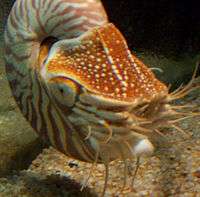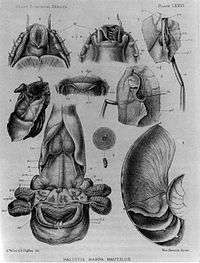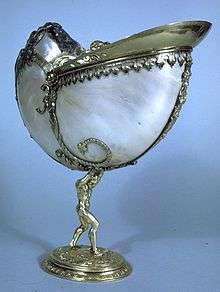Chambered nautilus
| Chambered Nautilus Temporal range: Early Pleistocene to Recent | |
|---|---|
 | |
| Scientific classification | |
| Kingdom: | Animalia |
| Phylum: | Mollusca |
| Class: | Cephalopoda |
| Order: | Nautilida |
| Family: | Nautilidae |
| Genus: | Nautilus |
| Species: | N. pompilius |
| Binomial name | |
| Nautilus pompilius Linnaeus, 1758 | |
| Subspecies | |
| Synonyms | |
| |
The chambered nautilus, Nautilus pompilius also called the pearly nautilus, is the best-known species of nautilus. The shell, when cut away, reveals a lining of lustrous nacre and displays a nearly perfect equiangular spiral, although it is not a golden spiral. The shell exhibits countershading, being light on the bottom and dark on top. This is to help avoid predators, because when seen from above, it blends in with the darkness of the sea, and when seen from below, it blends in with the light coming from above.
The eyes of the chambered nautilus, like those of all Nautilus species, are more primitive than those of most other cephalopods; the eye has no lens and thus is comparable to a pinhole camera. The species has about 90 tentacles with no suckers, which is also different from other cephalopods. Chambered nautiluses, again like all members of the genus, have a pair of rhinophores located near each eye which detect chemicals, and use olfaction and chemotaxis to find their food.[1]
The oldest fossils of the species are known from Early Pleistocene sediments deposited off the coast of Luzon in the Philippines.[2]
In 2011, scientists became alarmed at declining populations of nautilus resulting from overfishing, and have been studying world populations to determine the need for protection under the United Nations Convention on International Trade in Endangered Species. As of the 3rd of Oct, 2016 at 8:15 pm during CITES Cop17 in Africa, all Nautilids were adopted into Appendix 2. Offering them higher protection from massive trade demand.[3]
Subspecies
Two subspecies of N. pompilius have been described: N. p. pompilius and N. p. suluensis
N. p. pompilius is by far the most common and widespread of all nautiluses. It is sometimes called the emperor nautilus due to its large size. The distribution of N. p. pompilius covers the Andaman Sea east to Fiji and southern Japan south to the Great Barrier Reef. Exceptionally large specimens with shell diameters up to 268 mm (10.6 in)[4][5] have been recorded from Indonesia and northern Australia. This giant form was described as Nautilus repertus, but most scientists do not consider it a separate species.
N. p. suluensis is a much smaller animal, restricted to the Sulu Sea in the southwestern Philippines, after which it is named. The largest known specimen measured 160 mm in shell diameter.[6]
Shell geometry
The chambered nautilus is often used as an example of the golden spiral. While nautiluses show logarithmic spirals, their ratios range from about 1.24 to 1.43, with an average ratio of about 1.33 to 1. The golden spiral's ratio is 1.618. This is actually visible when the cut nautilus is inspected.
In literature and art

Nautilus shells were popular items in the Renaissance cabinet of curiosities and were often mounted by goldsmiths on a thin stem to make extravagant nautilus shell cups, such as the Burghley Nef, mainly intended as decorations rather than for use. Small natural history collections were common in mid-19th-century Victorian homes, and chambered nautilus shells were popular decorations.
The chambered nautilus is the title and subject of a poem by Oliver Wendell Holmes, in which he admires the "ship of pearl" and the "silent toil/That spread his lustrous coil/Still, as the spiral grew/He left the past year's dwelling for the new." He finds in the mysterious life and death of the nautilus strong inspiration for his own life and spiritual growth. He concludes:
- Build thee more stately mansions, O my soul,
- As the swift seasons roll!
- Leave thy low-vaulted past!
- Let each new temple, nobler than the last,
- Shut thee from heaven with a dome more vast,
- Till thou at length art free,
- Leaving thine outgrown shell by life's unresting sea!
A painting by Andrew Wyeth, entitled "Chambered Nautilus", shows a woman in a canopied bed; the composition and proportions of the bed and the window behind it mirror those of a chambered nautilus lying on a nearby table.
The popular Russian rock band Nautilus Pompilius (Наутилус Помпилиус) is named after the species.
American composer and commentator Deems Taylor wrote a cantata entitled The Chambered Nautilus in 1916.
 Cutaway of a nautilus shell showing the chambers
Cutaway of a nautilus shell showing the chambers Empty nautilus shell, whole
Empty nautilus shell, whole Nautilus showing the tentacles
Nautilus showing the tentacles Internal anatomy of Nautilus pompilius
Internal anatomy of Nautilus pompilius
References
- ↑ Basil, Jennifer A.; et al. "Three-dimensional odor tracking by Nautilus pompilius" (PDF). Journal of experimental biology. 203 (9).
- ↑ Ryoji, W.; et al. (2008). "First discovery of fossil Nautilus pompilius (Nautilidae, Cephalopoda) from Pangasinan, northwestern Philippines". Paleontological Research. 12 (1): 89–95. doi:10.2517/1342-8144(2008)12[89:FDOFNP]2.0.CO;2.
- ↑ Broad, William (24 October 2011). "Loving the Chambered Nautilus to Death". The New York Times. Archived from the original on 27 October 2011. Retrieved 24 October 2011.
- ↑ Nautilus repertus ID:118764. Shell Encyclopedia, Conchology, Inc.
- ↑ Harasewych, M.G. & F. Moretzsohn (2010). The Book of Shells: A lifesize guide to identifying and classifying six hundred shells. A & C Black Publishers, London.
- ↑ Nautilus pompilius suluensis ID:626793. Shell Encyclopedia, Conchology, Inc.
- ↑ "Nautilus Cup". The Walters Art Museum.
- Norman, M. 2000. Cephalopods: A World Guide. Hackenheim, ConchBooks, pp. 30–31.
- Pisor, D. L. (2005). Registry of World Record Size Shells (4th ed.). Snail's Pace Productions and ConchBooks. p. 93.
External links
| Wikimedia Commons has media related to Nautilus pompilius. |
| Wikisource has the text of the 1921 Collier's Encyclopedia article Pearly nautilus. |
- "CephBase: Chambered nautilus". Archived from the original on 2005.(Nautilus pompilius pompilius)
- "CephBase: Chambered nautilus". Archived from the original on 2005.(Nautilus pompilius suluensis)
